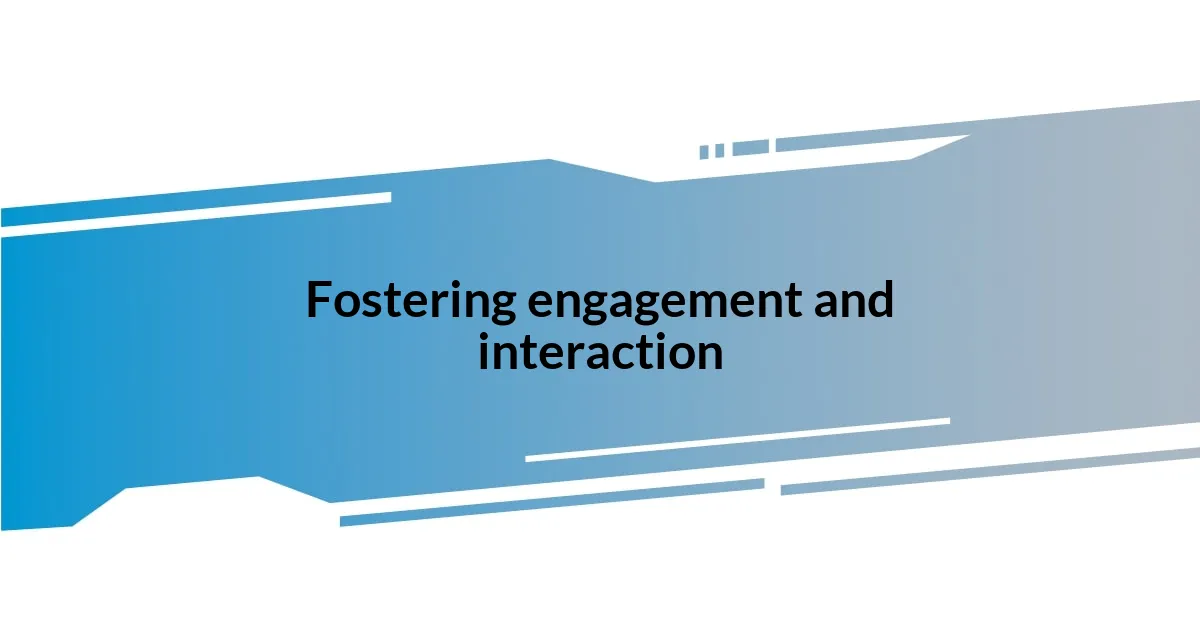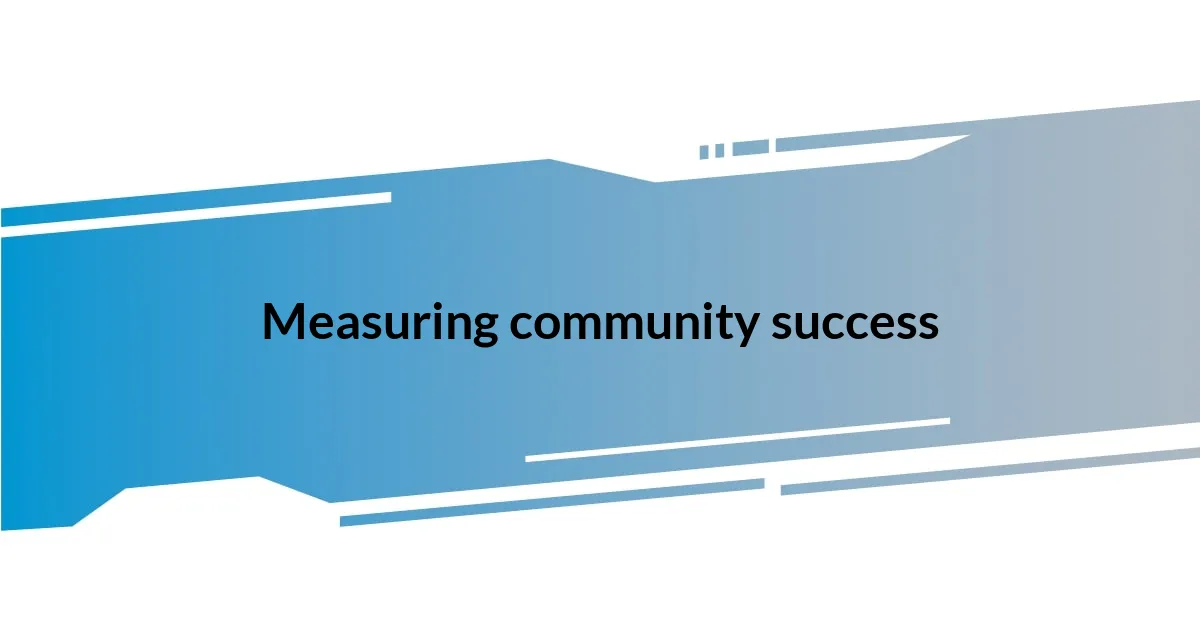Key takeaways:
- Building community requires intentionality, vulnerability, and nurturing relationships that embrace diverse backgrounds and shared interests.
- Strong communities provide support, inspire collaboration, and foster a sense of belonging, enhancing personal connections and collective problem-solving.
- Effective communication and social media utilization are crucial for engagement and measuring community success, allowing for genuine connections and immediate responses to needs.

Understanding community building
Understanding community building is like planting a garden. You must nurture relationships, giving them the right environment to grow. I remember when I first joined a local book club, and the initial awkwardness of introductions quickly transformed into deep discussions. It was through shared love for reading that bonds were formed, showing me how common interests can spark connection.
As we foster our communities, it’s crucial to recognize the diverse backgrounds and experiences each person brings. I often ponder how differences can enrich our gatherings rather than create barriers. For instance, during a community event I attended, we invited people from various cultures to share their traditions. That evening, I felt a profound sense of belonging, realizing that our unique stories added depth to our shared experiences.
Building a community involves intentionality and vulnerability. Have you ever felt hesitant to share your thoughts in a group? I have. When I finally opened up about my challenges, the support and encouragement I received from others transformed my perspective. It reinforced my belief that community thrives on authenticity, where everyone feels safe to express themselves.

Importance of strong communities
Strong communities act as a safety net, providing support in challenging times. I recall a period in my life when I faced a job loss. It was my community that rallied around me—offering job leads, advice, and even a meal now and then. This experience made me realize that when we create strong bonds, we aren’t just forging friendships; we’re building a network of support that can uplift us during adversity.
Moreover, vibrant communities foster a space for collaboration and innovation. I remember attending a community workshop where people from various fields came together to brainstorm solutions to local issues. The energy was palpable, and I witnessed firsthand how diverse perspectives could spark ideas that one person alone might never conceive. This kind of synergy can lead to remarkable outcomes, benefiting not just the individuals involved but the entire community.
The impact of strong communities extends beyond personal connections; they contribute to a sense of belonging. I once volunteered for an event that celebrated our local culture. Seeing familiar faces come together to enjoy the festivities reminded me of the importance of shared experiences. It’s in those moments I understand how strong communities can nurture pride and identity, making every member feel valued and connected.
| Aspect | Importance |
|---|---|
| Support | Acts as a safety net during challenges |
| Collaboration | Encourages innovation and collective problem-solving |
| Belonging | Fosters a sense of identity and connection |

Identifying your target audience
Identifying your target audience is like putting together a puzzle. The pieces represent different groups of people, each with their own interests and needs. I remember brainstorming for a community garden project; we conducted surveys to learn what flowers and vegetables residents wanted. This effort not only excited potential participants but also ensured that our planning was truly reflective of their desires.
To effectively identify your target audience, consider the following aspects:
- Demographics: Age, gender, income, and education level can reveal key insights.
- Interests and Hobbies: Understanding what activities your audience enjoys will guide your approach.
- Challenges and Needs: Recognizing what problems they face can help you tailor your offerings.
- Communication Preferences: Knowing how they like to receive information—email, social media, or in-person communication—can enhance engagement.
- Feedback Loops: Create opportunities for dialogue to gain insights directly from the community.
Getting to know who you’re connecting with brings clarity and focus to your community-building efforts. During another initiative I led, we hosted a community forum where attendees shared their thoughts and concerns openly. It was heartwarming to see how empowered they felt speaking directly about their experiences. It underscored to me that truly understanding your audience isn’t just about collecting data—it’s about building relationships and fostering a sense of belonging.

Effective communication strategies
Effective communication strategies are vital for nurturing a sense of community. I’ve found that active listening can make a world of difference. For example, during a neighborhood association meeting, I noticed a resident hesitated to voice her concerns about local traffic issues. When I encouraged her to share, the dialogue that followed not only validated her feelings but also sparked creative solutions that involved everyone’s input. How often do we miss valuable insights simply by not giving others the space to express themselves?
Additionally, utilizing multiple communication channels can significantly enhance outreach. When planning events for my community, I regularly leverage social media, newsletters, and flyers. One summer festival, we used a dedicated hashtag to encourage attendees to share their experiences live. This interactive approach not only provided immediate feedback but also fostered excitement and engagement among community members. Isn’t it interesting how different platforms can amplify our voices and connect us more deeply?
Lastly, fostering a culture of transparency builds trust and encourages participation. I recall leading a project to revitalize a local park, where we held open forums to discuss plans and budget allocations. By being upfront about our intentions and challenges, more residents felt comfortable contributing their ideas and concerns. This kind of openness creates an environment where everyone feels valued and heard. Isn’t it refreshing to know that when we communicate effectively, we’re not just sharing information; we’re inviting collaboration and strengthening our community ties?

Utilizing social media platforms
Utilizing social media platforms has revolutionized how communities come together. I remember one instance where we launched a community safety initiative on Facebook. By creating a dedicated group, we not only spread awareness but also encouraged neighbors to share real-time updates about local activities. It was heartening to witness how quickly people rallied around this cause, reinforcing the idea that a digital space can indeed foster genuine relationships.
When I reflect on using Instagram for community engagement, it’s hard not to smile at the memories. We decided to host a photo challenge, encouraging residents to share images of our neighborhood’s hidden gems. The influx of posts not only highlighted the beauty of our community but also led to strangers becoming friends through their shared enthusiasm. Isn’t it fascinating how a simple hashtag can create connections that might never have happened otherwise?
One powerful aspect of social media that I’ve come to appreciate is the ability to respond instantly to community needs. After a severe storm hit our area, we utilized Twitter to coordinate recovery efforts swiftly. The outpouring of support was overwhelming—people offered everything from tools to help remove debris to homemade meals for those affected. This experience reinforced my belief in social media as a tool not just for communication, but for enabling action. What’s more empowering than knowing that a community can come together, united by a common purpose, all through the click of a button?

Fostering engagement and interaction
Building engagement and interaction in a community isn’t just about organizing events—it’s about creating opportunities for genuine connections. I’ll never forget the coffee mornings we held at our local library. The simple act of gathering allowed residents to share their stories, and it was incredible to see friendships blossom over cups of coffee. Each conversation helped deepen our understanding of one another, reminding me how powerful it is to foster a space where people feel encouraged to participate. Have you ever experienced that moment when a casual chat leads to something unexpected and meaningful?
In my experience, interactive workshops have been a game-changer for fostering engagement. I once facilitated a community art project, inviting everyone to contribute their own piece to a collective mural. The day was filled with laughter, and watching neighbors help each other with paint brushes and ideas was a joy to behold. It was more than just creating art; it brought us together in a way that simply attending a meeting never could. What happens when we let creativity break down barriers between us?
Moreover, hosting regular feedback sessions creates a sense of ownership within the community. I remember initiating a series of discussions after we started a new recycling program. Inviting everyone to share their thoughts and suggestions not only improved the initiative but also sparked a shared responsibility among residents. Each voice contributed to the evolution of the program, and it felt great to witness that shift in mindset. Isn’t it inspiring how an open platform can transform feelings of apathy into active involvement?

Measuring community success
Measuring community success is essential to understanding the impact of our efforts. I often reflect on a community event we organized, where we set clear goals for attendance and engagement. Afterward, we analyzed feedback forms, which illuminated not only how many people participated but also what they felt about the experience. It was enlightening to see that a simple number could reflect a deeper connection and satisfaction among attendees.
Another approach I’ve found effective is tracking online interactions. When we launched a community newsletter, I initially focused on open rates and click-through rates, but soon realized that quoting individual stories from our readers added a personal touch. Those moments of connection revealed how much the newsletter meant to them—making the numbers come alive. Isn’t it interesting how behind every statistic lies a unique story?
I also believe that qualitative measures can be incredibly revealing. For instance, during a neighborhood watch initiative, we started collecting stories of residents who felt safer after our efforts. Those personal testimonies were like gold. They provided invaluable insights and helped us redefine our goals moving forward, proving that success isn’t just about numbers—it’s about fostering meaningful change and connections. Have you ever thought about how storytelling can reshape our entire understanding of community?
